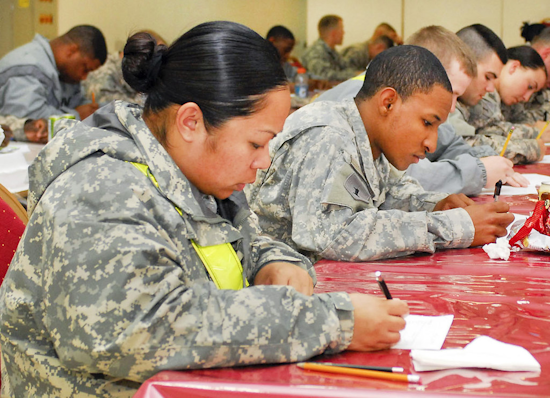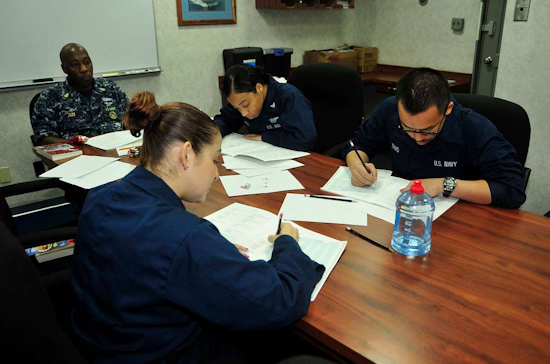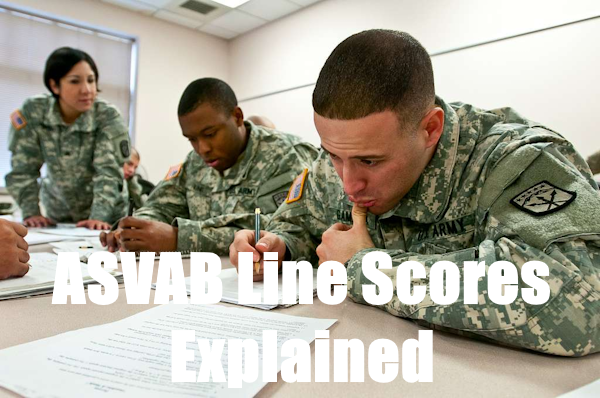What is the purpose of ASVAB line scores?
The Armed Services Vocational Aptitude Battery (ASVAB) is a military exam designed to test your knowledge of basic concepts and special skills.
Those who perform well on the ASVAB are eligible for better military careers and ranks, along with higher pay.
However, before you ace the ASVAB, it’s important to understand the meaning of line scores.
Discover everything you need to know about ASVAB line scores, below.
Related Article – GT Score Explained (And How To Raise It)
Table of Contents
ASVAB Line Scores Explained

The Armed Services Vocational Aptitude Battery (ASVAB) is one of the first steps toward enlisting in the military.
It represents a series of exams that individuals who are interested in joining the military after high school or college take before they graduate or any time thereafter.
The ASVAB tests the information you learned in high school as well as general technical knowledge and mechanical comprehension.
Therefore, it’s helpful to understand what’s all in the ASVAB along with how line scores determine your military rank and pay grade.
It’s also crucial to perform well on the ASVAB because it dictates what service branches and military jobs you are eligible to perform while serving the nation.
Students that take the ASVAB exam receive multiple scores:
- AFQT Line Score
- ASVAB Standard Line Score
- ASVAB Composie Line Score
What is the meaning and purpose of ASVAB line scores?
Learn more by reviewing the purpose of standard line scores, AFQT line scores, and composite scores:
ASVAB Standard Line Scores Explained
The final score you receive on the Armed Services Vocational Aptitude Battery (ASVAB) is the culmination of 3 different line scores.
First, ASVAB standard line scores are calculated for each of the 9 sections of the ASVAB.
Thus, the primary standard line sections of the ASVAB are as follows:
- General Science (GS)
- Arithmetic Reasoning (AR)
- Word Knowledge (WK)
- Paragraph Comprehension (PC)
- Mathemathics Knowledge (MK)
- Electronics Information (EI)
- Auto and Shop Information (AS)
- Mechanical Comprehension (MC)
- Assembling Objects (AO)
First and foremost, you don’t have to master all 9 categories of the ASVAB exam.
Rather, it’s crucial to focus on the skills and knowledge you already perform well doing or enjoy doing.
Notwithstanding, brushing up on general knowledge and some of the information learned from high school is also helpful.
Additionally, the goal is to score high enough to earn eligiblity for a service branch or job you want to do in the military.
The U.S. Armed Forces determines military occupations, ranks, and pay for new recruits largely based on the score of the ASVAB exam.
Thus, it’s important to not overlook the military exam and study beforehand.
ASVAB Standard Line Scores Calculations
The U.S. Armed Forces receives a score for each of the 9 sections of the ASVAB test.
Next, the military takes the average (or “mean”) from the 9 sections to determine a final standard line score.
It’s worthwhile to mention that the U.S. government scores each candidate based on this mean, and not their actual score on the exam.
In other words, a score of 60 represents that the individual scored 1 standard deviation above the mean / average.
Meanwhile, a score of 70 would indicate that the individual scored 2 standard deviations over the mean / average.
The opposite is true for any performance below 50, but may not completely disqualify you from service.
Bottom line: The ASVAB standard line scores measure your performance against the “mean,” or other students who completed the test that year.
However, performing poor in certain categories does not usually disqualify you from service but rather determines areas of speciality compared to areas of weakness.
Nevertheless, scoring high on the ASVAB is an outstanding opportunity to get a higher starting pay and more prestigious military job.
Related Article – ASVAB Scores And The Military Jobs That Qualify
AFQT Scores Explained

Next, the ASVAB tests new candidates with the Armed Forces Qualification Test (AFQT).
The AFQT score specifically determines whether the candidate is eligible for duty and/or what military branches they qualify for service.
For example, each service branch of the U.S. Armed Forces has different minimum AFQT score requirements:
- United States Army = 31 (AFQT score)
- S. Air Forces = 36 (AFQT score)
- Marine Corps = 32 (AFQT score)
- United States Navy = 35 (AFQT score)
- S. Coast Guard = 40 (AFQT score)
Therefore, if you are interested in attending a specific branch of the U.S. Armed Forces new candidates should attempt to achieve at least the minimum AFQT score.
Finally, it’s worthwhile to mention that new candidates who do not have a high school diploma (but have acquired a GED) must meet different minimum requirements.
AFQT Line Scores Calculations
The United States Armed Forces combines the AFQT score by merging the average / mean of 4 categories:
- Arithmetic Reasoning (AR)
- Mathematics Knowledge (MK)
- Paragraph Comprehension (PC)
- Word Knowledge (WK)
Once again, the U.S. military reaches a final score for the AFQT in a system of percentiles comparable to the standard line scores.
Thus, an AFQT score of 60 equals 1 standard deviation above the mean / average.
Meanwhile, an AFQT score of 40 equals 1 standard deviation below the mean / average.
The United States Coast Guard, Air Force, and Navy have the highest minimum standards for AFQT line scores.
On the other hand, the U.S. Army and Marine Corps have slightly lower AFQT standards for those that struggle with the math, writing, or reading portions of the exam.
Related Article – AFQT Explained: 5 Tricks To Get The Best Score Possible
Composite Scores Explained
Finally, the ASVAB also takes into account composite line scores.
Composite scores, more frequently referred to as “line scores”, help determine eligible military occupations.
As such, the U.S. military has higher requirements for some composite scores compared to others.
For example, it’s much more difficult to qualify as a U.S. military pilot compared to other military jobs.
Be that as it may, the U.S. military is always seeking new enlistments and can find a position that best suits your talents and knowledge.
More importantly, joining the military can also lead to getting the education paid by Uncle Sam but that’s only if you first achieve a high score on the ASVAB.
Consequently, make sure to take composite line scores seriously especially if you want to serve a particular role or function in the U.S. military.
In general, the U.S. Armed Forces classifies the following 10 ASVAB line / composite scores:
- Clerical (CL)
- Combat (CO)
- Electronics (EL)
- Field Artillery (FA)
- General Maintenance (GM)
- General Technical (GT)
- Mechanical Maintenance (MM)
- Operators & Food Service (OF)
- Surveillance & Communications (SC)
- Skilled Technical (ST)
According to the U.S. Armed Forces, each service branch is responsible for determining which composite line scores are applicable for the military jobs in that branch.
Therefore, each military branch has its own application process and eligibility requirements.
Notwithstanding, ASVAB line scores fluctuate depending on specific military ratings (or occupations) that are in high demand or where a shortage exists.
Thus, new candidates should focus on skills and information they already perform well and connect it with the applicable composite scores:
Clerical (CL)
The military has office jobs and roles that fit under the category of Clerical (CL).
Those that are interested in a clerical military career need to focus on performing well in the following segments of the ASVAB:
- Word Knowledge (WK)
- Paragraph Comprehension (PC)
- Arithmetic Reasoning (AR)
- Mathematics Knowledge (MK)
You’ll discover that every military occupation has certain portions of the ASVAB that new candidates must score high enough on in order to qualify for that military role.
Combat (CO)
Combat (CO) roles in the military are always in demand.
Currently, the U.S. Armed Forces seeks new candidates who perform well in Word Knowledge (WK) and Paragraph Comprehension (PC).
Furthermore, combat military jobs monitor performance in Auto & Shop Information (AS) and Mechanical Comprehension (MC).
Electronics (EL)
Those in the military that work for Electronics (EL) operate on highly sophisticated and advanced military equipment.
Therefore, you’ll need to score high in the following categories: General Science (GS), Arithmetic Reasoning (AR), Mathematics Knowledge (MK), and Electronic Information (EI).
Field Artillery (FA)
Field Artillery (FA) is comparable to combat military positions aside from specializing in explosives or another powerful weapon.
Those interested in Field Artillery (FA) must score high in Arithmetic Reasoning (AR), Mathematics Knowledge (MK), and Mechanical Comprehension (MC).
General Maintenance (GM)
General Maintenance (GM) encompasses a wide variety of military jobs, including repairing helicopters and aircraft.
The ASVAB sections that count the most are General Science (GS), Auto & Shop Information (AS), Mathematics Knowledge (MK), and Electronics Information (EI).
General Technical (GT)
General Technical (GT) military jobs are similar to General Maintenance yet with a bigger focus on writing and problem solving.
Therefore, focus on performing well regarding Word Knowledge (WK), Paragraph Comprehension (PC), and Arithmetic Reasoning (AR).
Mechanical Maintenance (MM)
Mechanical Maintenance (MM) is another prime opportunity for gearheads that like working with their hands.
The most important sections of the ASVAB include: Auto & Shop Information (AS), Mechanical Comprehension (MC), and Electronic Information (EI).
Operators & Food Service (OF)
The U.S. Armed Forces lumps Operators and Food Service (OF) under one definition.
Those who are considering this military speciality should focus on Word Knowledge (WK) and Paragrah Comprehension (PC).
Additionally, Operators & Food Service (OF) are monitored in Auto & Shop Information (AS) and Mechanical Comprehension (MC).
Surveillance & Communications (SC)
The military role of Surveillance & Communications (SC) is expanding in the modern era.
As a result, those who are interested in Surveillance & Communications need to excel at Word Knowledge (WK) and Paragraph Comprehension (PC).
Moreover, the ASVAB tests candidates in Auto & Shop Information (AS) and Mechanical Comprehension (MC).
Skilled Technical (ST)
Skilled Technical (ST) covers military occupations that do not qualify under General Technical (GT).
These military jobs are usually more advanced and come with better pay and benefits.
Interested candidates need to focus on General Science (GS), Mechanical Comprehension (MC), and Mathematics Knowledge (MK).
Furthermore, new candidates are examined in Word Knowledge (WK) and Paragraph Comprehension (PC).
ASVAB Composite / Line Scores Calculations
It’s critical to comprehend how ASVAB line scores are calculated in order to prepare for the exam.
The purpose of the ASVAB test is to determine the strengths and weaknesses of each candidate.
Therefore, if you want to serve a specific role in the military, you’ll want to focus on specific sections of the exam.
In the end, the U.S. Armed Forces calculates a number for each of the 10 ASVAB line scores.
Military branches require that new candidates meet minimum standards for every military job, which is what makes composite scores so important.
These line scores essentially determine what you’ll be doing in the military and what rank you’ll begin serving the nation.
ASVAB Line Scores by Military Branch

The U.S. Armed Forces features several different service branches worth enlistment.
However, each service branch has different guidelines and minimum standards in regards to the ASVAB.
Army composite scores, like the other military branches, determines a job occupation.
In general, the U.S. Army classifies new recruits based on their score on General Technical (GT).
Then, the Army considers the 10 composite scores from the ASVAB for job placement.
Meanwhile, the United States Air Force creates 4 composite sections (known as MAGE) from the ASVAB and considers those for qualification:
- Administrative
- General Mechanical
- Electronics
- General Aptitude
Lastly, the U.S. Navy and Coast Guard do not use ASVAB line scores.
Rather, these service branches determine qualification from the direct results of the ASVAB subtest / standard line scores.
Thus, if a particular military job requires a minimum score of 75, then the candidate needs to score a combined 75 from the applicable subtests / standard line scores.
For example, combining to score 80 on the General Science (GS), Auto & Shop Information (AS), and Mathematics Knowledge (MK) portions would qualify for General Maintenance (GM).
Related Article – ASVAB ST Score Explained And Potential Army Careers
Conclusion
It’s important to understand the role of ASVAB line scores.
Composite scores dictate what military job and rank, among other critical factors for new recruits.
Accordingly, it’s vital to comprehend how ASVAB line scores impact eligible military jobs.
Currently, the ASVAB divides scores into 3 different categories: standard line scores, AFQT scores, and composite line scores.
- Replacing Dog Tags: 6 Things You Need to Know - June 28, 2024
- Navy OAR Test Study Guide - June 24, 2024
- 10 Best Sniper Movies of all Time - June 20, 2024
Originally posted on October 19, 2023 @ 4:45 pm
Affiliate Disclosure: This post may contain affiliate links. If you click and purchase, I may receive a small commission at no extra cost to you. I only recommend products I have personally vetted. Learn more.

